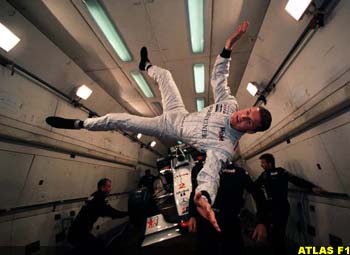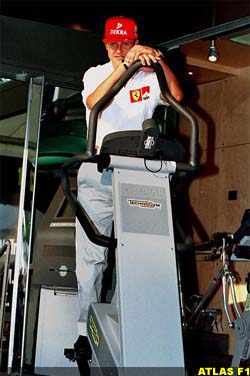|
| |||
 |
Taking the Lid Off F1 Formula One Technical Analysis | ||
| by Will Gray, England | |||
|
Atlas F1 presents a series of articles by certified engineer Will Gray, that investigates in greater depth all the technical areas involved in design, development, and construction of a Formula One car.
In a race, the driver of an F1 car is subjected to massive vibrations, accelerations, and, unfortunately, occasional impacts. These combine with intense heat, and an intense amount of physical work over one and a half racing hours, to create significant physiological effects on chemical (blood content, oxygen consumption), and physical (blood pressure, heart rate) areas of a driver's body. Accelerations and vibrations are measured in 'g-forces'. When you sit down, your body weight experiences the force of gravity - or 1g. However, if someone pushes down on your head, it experiences another downward force. To simplify matters, this force is given a value related to the force of gravity. This is the same phenomenon a racing driver will experience when going over bumps - only the force is applied by the motion of the car and occurs for fractions of a second. When a vertical force of 2g is experienced, your body will feel twice as heavy as it does normally - hence two times the value of gravity. Basically, g's allow acceleration to be measured on a simple scale, and it works in negative values, too. One g is normal, two g is twice the normal force. The range between zero and 1g has been experienced by most people - when you drive over a humpback bridge, you feel a lightening sensation. This is because the accelerative forces experienced going in a curve over the bridge contra the downward force of gravity, leaving a net force of below 1g.
The vibrations experienced by an F1 driver are quite intense. Data shows that maximum vertical vibrational accelerations of 3g are experienced by the driver for split seconds. In this case, vibrations are random and are due to the bumps on the track surface. These vibrations occur at just the frequency which humans find uncomfortable - even the super humans! Short term effects are minimal, with an elevated heart rate and muscle tension being the two major effects, as well as slightly impaired vision. In the long term, however, people exposed to intense whole body vibration have increased spine and nervous system problems. An investigation into the softening of suspension on F1 cars showed decreased back pains with soft suspension, but unfortunately for the driver, for the best performance, engineers want as stiff a car as possible, which is why drivers must suffer such intense vertical vibration. However, these vibrations, if exceptionally bumpy, can cause problems in accelerating and braking, as a driver's foot bounces up and down on the pedals. It's not only vibrations which cause discomfort and awkwardness for the drivers. Large lateral (sidewards) accelerations are experienced, depending on the speed and length of the corner. The car, and therefore the body, will sustain maximum sidewards forces of up to 3g. The hands are positioned on the steering wheel so that side forces act through its centre, so preventing accidental turning. As the head is the only unsupported part of the body, drivers' necks must be very strong to resist these forces, which with the head being 6.5% of the body weight and the helmet weighing around two kilos, amounts to a lateral force on the neck muscles of about 210N (that's a lot!). Longitudinal accelerations are those which try to push the driver forwards or backwards. These are also severe, particularly under braking, where forces as large as negative 4g can be seen, reaching just over positive 1g when accelerating. These forces are less of a problem on the body than lateral accelerations, as the body is more supported by the seatbelts, but the head is still free to be forced forward. The effects of negative longitudinal g on vision are significant when over -3g. This is experienced when braking for a corner and can result in blurring of vision, which will reduce the accuracy of hitting an apex when turning - so a driver often cannot see the corner he is heading into!
Braking is so hard that reaction time is very significant. In a road car as speed increases, importance of reaction time decreases because at higher speeds it takes the car longer to stop. Here, in a car which can accelerate to 100 km/h and back to zero in six seconds, the 0.7 seconds of thinking time required remains critical. It is also interesting to note that hands are faster than feet at reacting, which suggests the hand held clutch is better in a spin and may give some indication that hand braking may be more efficient. In braking, there is one decision - brake or not. This makes reaction time quick. In steering, there are two choices - left or right, and this increases reaction time by about 70%. Reaction time also is at a minimum between the ages of 20 and 30, suggesting one reason for a driver's career span. The environment is a severe one for the driver to cope with. Suspension systems can be designed to cope with bumps, but as usual, a compromise must be made. This one is between driver comfort and car performance, and sorry Mr driver, you know which one is more important to the team!
Previous Parts in this Series: Parts 1 & 2 | Part 3
|
| Will Gray | © 1999 Kaizar.Com, Incorporated. |
| Send comments to: gray@atlasf1.com | Terms & Conditions |
A recent addition to the Atlas F1 staff, Will Gray has worked for three years at Jordan Grand Prix as a Junior Aerodynamicist. He also worked for Ray Mallock Ltd (Touring Cars), and scrutineered at the 1995 and 1996 Grands Prix of Australia, as well as the Tooheys 1000 (Bathurst, Australia, 1995). Will previously published articles in RaceCar Engineering magazine, and in Autosport magazine (Club section). He currently attends the University of Southampton and resides in the UK. | |

